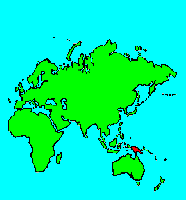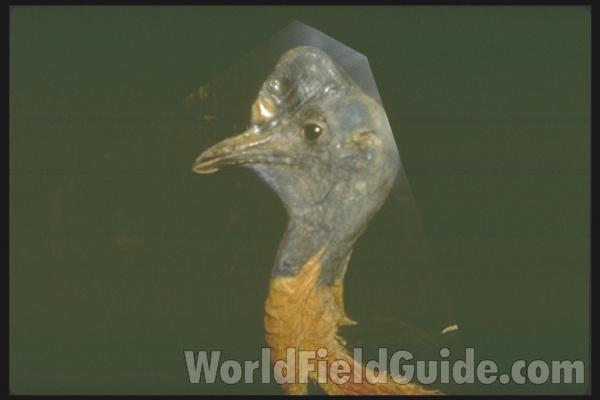SPECIES INFO
Australian, or Southern, Cassowary (Casuarius casuarius) is found in northern Australia and New Guinea. This is a brown flightless bird that shows blue when adult on the side of its neck. This large bird can be up to about 5 feet in length. There are small vertical hairs on the top of its head. These hairs form a somewhat tall head crest.
Some authors separate the New Guinea forms from the forms found on Aru and Ceram. Others do not accept these subspecies.
The combined populations of Queensland (northern Australia) and New Guinea were mentioned in Birdwatch in 2011 to be about 10,000 to 19,000 specimens.Cassowary genus (Casuarius) contains 3 species of flightless birds. They are found from Australia north into New Guinea and onto several adjacent islands. Although these birds are generally shy and hard to observe, when provoked they can be very dangerous. When they attack, they jump feet first, and their sharp dangerous claws have killed many humans.
Cassowary tribe (Casuariini) is a tribe of large flightless birds found in northern Australia, New Guinea, and adjacent islands. Although over 30 forms have been described, recent thinking has been to combine these into three different species:
Southern (C. casuarius) - NE Australia & New Guinea
Dwarf Cassowary (C. bennetti) - New Guinea & New Britain
One Wattled Cassowary (C. unap.) - Indonesia
Cassowary family (Casuariidae) contains two tribes. The Emus and the Cassowaries. These are large flightless birds found in the Australian region.
Emu tribe has only one remaining species.
Cassowaries are large birds that are found in the tropics of Australia and New Guinea. Although there have been many forms described, they are usually combined into three distinct species.
In older works, the ostrich, rheas, cassowaries (including the emu), and kiwis were each given their own order. In newer works there are numerous methods of grouping these flightless birds together. Herein we have followed Monroe and Sibley 1993 wherein these flightless birds were each given family status and grouped into the Struthioniformes order.
Aves contains about 8,650 different species of living birds known to science. Each year about one new species is discovered in some remote rain forest or remote island. In addition, scientists have been raising many subspecies to full species status which may raise the species count to 10,000. Birdlife recognizes 10,027 species as of 2011.
However, each year about one species goes extinct. The rate of extinction is increasing, and the rate of new discovery is decreasing, so that the number of bird species will soon begin to decline rapidly. Although different taxonomists would organize the birds differently, there are approximately twenty-seven orders of birds. These orders are broken down into about one hundred and fifty-five different families.
Recent research of the genetic structure of some of the shore birds and owls would indicate that the present organization of orders and families should have some modification.
The birds are a worldwide group of animals that are characterized by having the front limbs modified into wings that are used for flying. Perhaps the most unique feature of the birds is the feathers. These feathers are made up of a central support called a quill and a series of small filaments that are hooked together as barbs.
For many years it was believed that Archaeopteryx discovered in Bavaria was the oldest bird from about 150 million years ago. However, in l986, Sankar Chattterjee, a Texas paleontologist, reportedly discovered a bird in the genus Protoavis that lived about 225 million years ago.
When this project was begun in 1978, we used Austin & Singer for bird taxonomy. Since then, we have adopted many changes, but have kept some older concepts that are still found widely in the literature. Recently, we have used Clements and Howard & Moore. Very recently, we have used Monroe and Sibley for the higher taxonomy of the perching birds.
Backboned Animals (Phylum Chordata) are the most advanced group of animals on earth. These animals are characterized by having a spinal cord or backbone. Most members have a clearly defined brain that controls the organism through a spinal cord. Fish, amphibians, reptiles, birds, and mammals are in this phylum.
Currently, some taxonomists believe that the fish should be divided into two groups (sharks and regular fishes) and that there are some other primitive groups in the phylum such as hagfish or lampreys.
Animal Kingdom contains numerous organisms that feed on other animals or plants. Included in the animal kingdom are the lower marine invertebrates such as sponges and corals, the jointed legged animals such as insects and spiders, and the backboned animals such as fish, amphibians, reptiles, birds, and mammals.




